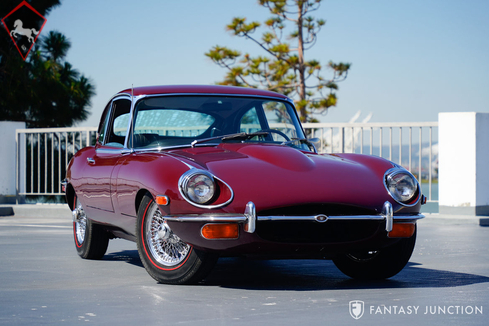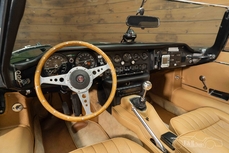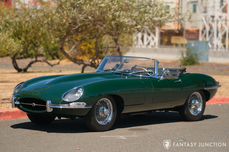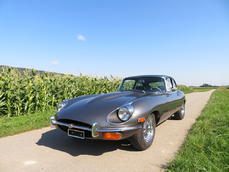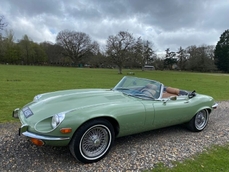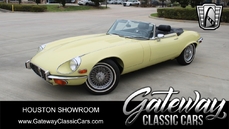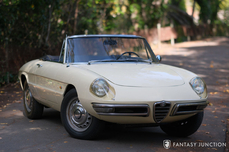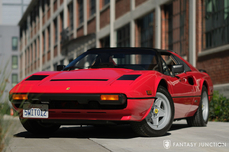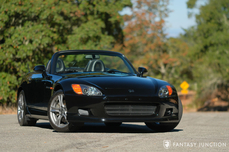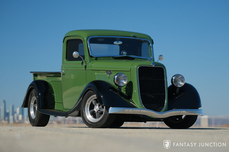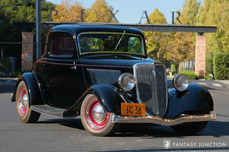Jaguar E-type 4.2L inline 6-cylinder 1969
Allgemeine Beschreibung :
1969 Jaguar XKE Series II 2+2 Coupe
Chassis Number – 1R41090BW
Engine Number – 7R36540-9
Exterior Color – Regency Red
Interior Color – Black leather seats with vinyl door cards, dash, & console
Engine – 4.2 Liter DOHC in-line six-cylinder engine
Transmission – 3-Speed Borg Warner Automatic
Current Miles – 75,399 miles (TMU)
- Original California ownership since purchased new in 1969
- Matching numbers engine with functional factory Air Conditioning and power brakes
- Accompanied by a complete spare leather and vinyl interior still in plastic wrapping
General History
Beautiful body lines, unrivaled performance, and racing lineage combined at the dawn of the 1960s to make the Jaguar XKE an immediate sensation. With its beautiful design and affordable price, the E-Type grew to iconic status where it continues to be adored by collectors and enthusiasts worldwide. Independent front and rear suspension, disc brakes all around (inboard at the rear), and Jaguar’s legendary twin-cam inline six-cylinder engine were among the many performance features of the legendary XKE. Sales were brisk with continuous development growing in both American and European markets. In 1968, the Series II was launched which included open headlights, wraparound rear bumpers, larger taillights, and a larger grille with twin electric fans to aid in cooling.
Though initially developed to concurrently release with the original line up, the 2+2 model did not arrive in production until 1966. The added rear seating, while suitable for small passengers, created some packaging challenges to allow for the larger passenger compartment and taller roofline. While the proportions were unique to the 2+2 offering, by the late 60s the mechanical improvements across all models made for a very enjoyable car, capable of combining performance with stylish family transportation.
History of this Example
This Jaguar was purchased new in 1969 at Oxford Motors, Sacramento, CA by the original owner as a gift for his wife. She requested the car be painted Regency Red and trimmed in black leather interior. The car was delivered with automatic transmission, power brakes, air conditioning, chrome wire wheels, and an AM/FM multiband radio. Over time, as the owner aged, she found her 6’ 1” frame a bit challenging to negotiate the entrance and exit of the low-profile car. As such, she drove the car increasingly fewer miles as the years wore on, while her husband continued to maintain it. The car was stored indoors in a heated garage, keeping company with several other classic vehicles in their collection while the owner made sure it was regularly serviced including synthetic oil changes and occasional drives.
After being stored under another car on a lift at a service location, brake fluid dripped on the original paint. The car was stripped of the old paint and professionally repainted in 2022 using the correct Regency Red finish. The paint shop added a subtle hint of metallic micro-flake to the paint. The original speedometer, stuck from non-operation, was replaced at 55,000 miles. A correct used OEM unit indicating more miles that this car had traveled was installed. The original exhaust pipes and resonators have been replaced with Stebro stainless-steel units which are accurate to the original specification. In 2022, a new battery was installed along with new red line tires. In addition to service records dating back to 1991, this Jaguar is accompanied by California registration slips dating back to the original year of purchase, 1969.
Service invoices from British Car Service, Sacramento, CA, dating back to the early 1990s indicate general services including engine tune ups, hoses, oil changes, spark plugs, new motor mounts, and AC service. In 1994 a complete set of leather and vinyl replacement interior was purchased from G.W. Bartlett Co. (still in the protective plastic wrapping) and is included with the car.
In 2017 new door weather seals were installed, new brake hoses installed, a new speedometer cable and angle drive installed, new door glass seals, and a new rear bumper seal installed. In 2018 the head was removed, and a new head gasket installed along with new studs. In 2021 the dash top was removed and reupholstered. In preparation for sale, the car has been serviced, the oil pressure sending unit replaced, and new floats installed in the brake cylinder reservoir.
Current Condition
Today, this Jaguar XKE 2+2 boasts high gloss red exterior paint and much of the original black interior. Having been repainted in 2022, the paint is quite nice overall showing very well overall, though there are some visible imperfections when viewed up close. The lighting, lenses, and glass are in very good condition and bear correct branding marks consistent with original glass. The open headlight buckets and chrome trim are in excellent condition, as are the chrome front and rear bumpers. The body integrity is solid overall, with good panel gaps on the doors, bonnet, and rear hatch. The windshield surround is in very nice condition along with the chrome side glass trim and roof rail garnish molding. The car wears a set of chrome wire wheels which are in excellent condition, finished with chrome dual ear knockoffs and wearing a set of recently mounted red line tires. The overall visual presentation of the exterior is confident and poised with a nod to original California purchase and ownership, as indicated by the original black and yellow license plate, one of the last in the series before the 1970 blue and gold replacements.
The black leather and vinyl interior is clean and tidy overall presenting a mixture of original and reupholstered features. The front leather seats are comfortable and remain in very good condition, though appear to have been reupholstered some years ago. The rear seats appear original and in very good condition. The black vinyl trim including the door cards, door sills, carpet, floor mats, and matching center console are in generally good condition though some areas show signs of age and use. The black dash pad is properly contoured, having been replaced some years ago, and the instruments, switches, and other features of the interior all appear to be correct for this early Series II XKE. The correct under-dash mounted venting array and factory control module for the functional AC are properly mounted and the AC blows cold. The rear storage area is accessible through the hinged hatch and houses a matching wire wheel, jack and tire changing tools, and a knock off hammer. The interior conveys a harmonious look and feel very much in keeping with original specifications as delivered when new.
Under the hood, the original 4.2-liter engine is correct and consistent with factory presentation. The finishes are accurate for this series car and the engine compartment has been properly maintained though finishes are showing signs of age. The correct dual Stromberg carburetors, silver hammer-tone factory air cleaner assembly, and air filter box reflect original features and finishes. The car is outfitted with power brakes and air conditioning, both of which properly function. Consistent with the matching engine and correct chassis plate the front suspension “picture frame” is in place bearing the original matching chassis number. The undercarriage appears sound and tidy, while the overall integrity of the body seams, welded floors, and suspension components are consistent with original construction, benefiting from rust-free California ownership since delivered new. Various suspension components appear to be original to the car as well as the correct cast alloy oil pan, independent rear suspension cradle, and inboard rear brakes. A set of stainless-steel exhaust pipes and resonators are installed from the header exit pipes rearward.
Included with the car
This Jaguar is accompanied by a tire changing kit complete with jack, tools and bag, the original metal data card and plastic sheath, an original operators manual and plastic case, a business card and hand written letter from the salesperson at Oxford Motors who sold the car to the original and singular owner, California registration slips from 1969, and a complete set of black leather and vinyl upholstery, including seat bottom foam and carpet insulation, and several copies of magazines featuring articles on the Jaguar XKE.
1969 Jaguar E-type 4.2L inline 6-cylinder is listed zu verkaufen on ClassicDigest in California by Fantasy Junction for Preis nicht verfügbar.
Fakten der Auto
Karosserietyp : Auto Marke : Jaguar Modell : E-type Ausführung : 4.2L inline 6-cylinder Hubraum : 4.2 Modelljahr : 1969 Lage : Emeryville Fahrzeug Anmeldung : Normal
Preis nicht verfügbar
Angaben Zum Verkäufer
Fantasy Junction
Fantasy Junction
+1 510 653 7555
Fantasy Junction
+1 510 653 7555
People who viewed this Jaguar E-type also viewed similar Jaguar listed at ClassicDigest
Other cars listed for sale by this dealer
über Jaguar
Ah, die Geschichte von Jaguar, von seinen Anfängen als SS Cars Ltd. bis hin zum Höhepunkt mit dem D-Typ und der Straßenversion des ikonischen E-Typs. An dieser Erzählung haftet etwas zutiefst Britisches, und ich werde sie erzählen, wie es ein britischer Journalist tun würde.Die Anfänge:
Unsere Reise in die Welt von Jaguar beginnt in den 1930er Jahren, als ein Unternehmen namens SS Cars Ltd. auftauchte. Trotz des unglücklichen Zufalls ihrer Initialen, die mit den aufkommenden politischen Spannungen in Europa zusammenfielen, begannen sie, stilvolle und leistungsorientierte Autos herzustellen. Der SS 100, der 1936 eingeführt wurde, war ein Symbol für Eleganz und Geschwindigkeit und legte den Grundstein für das, was Jaguar werden sollte.
Die Geburt von Jaguar:
Als der Schatten des Zweiten Weltkriegs näher rückte, entschied sich SS Cars Ltd. klugerweise, sich von den SS-Initialen zu distanzieren. So wurden sie 1945 offiziell zu Jaguar Cars Ltd., ein Name, der bald für britischen Luxus und Leistung stehen würde.
Die XK-Serie:
Die Nachkriegszeit von Jaguar brachte uns den XK 120, eine wahre Sensation im Jahr 1948. Mit seinem schlanken Design und einem leistungsstarken 3,4-Liter-Sechszylindermotor wurde er zum schnellsten Serienauto der Welt. Der XK 120 war die Blaupause für das, was kommen würde - Jaguars, die Stil mit Geschwindigkeit auf einzigartig britische Weise verbanden.
Die Dominanz des D-Typs:
Dann kam der D-Typ, eine wahre Rennlegende. 1954 eingeführt, gewann er in den 1950er Jahren dreimal Le Mans und zeigte die technische Kompetenz von Jaguar. Mit seiner innovativen Monocoque-Konstruktion und der ikonischen Finne hinten war der D-Typ der Höhepunkt von Jaguars Motorsporterfolgen.
Das Auftauchen des E-Typs:
Aber der wahre Wendepunkt kam 1961 mit der Einführung des E-Typs, oft von Enzo Ferrari als "das schönste Auto, das je gebaut wurde" bezeichnet. Seine lange Motorhaube, die geschwungene Karosserie und ein 3,8-Liter-Motor, der atemberaubende Leistung lieferte, machten ihn sofort zu einem Klassiker. Der E-Typ war nicht nur ein Auto; er war ein Kunstwerk auf Rädern und konnte auf der Straße 150 Meilen pro Stunde erreichen.
Straßen- und Rennsporterfolge:
Die Schönheit des E-Typs wurde durch seine Leistung auf der Rennstrecke unterstrichen. Die leichten E-Typen waren bei verschiedenen Rennveranstaltungen besonders erfolgreich und festigten den Ruf von Jaguar als eine Kraft, mit der man im Motorsport rechnen musste.
Das Zeitalter der Raffinesse:
Je tiefer wir in die Geschichte von Jaguar eintauchen, desto mehr erkennen wir, dass die 1950er und 1960er Jahre ein Zeitalter der Raffinesse und Expansion waren. Neben dem großartigen D-Typ und dem ikonischen Aufstieg des E-Typs führte Jaguar Modelle ein, die seinen Ruf für Luxus und Leistung weiter festigten.
Der MK2:
Ende der 1950er Jahre stellte Jaguar den MK2 vor, eine Sportlimousine, die Eleganz mit Leistung vereinte. Diese elegante viertürige Limousine war sowohl bei Bankräubern als auch bei der Polizei aufgrund ihrer außergewöhnlichen Geschwindigkeit und Handhabung beliebt. Der MK2 war ein Symbol für Jaguars Fähigkeit, Raffinesse mit Leistung zu verbinden und hatte auch eine erfolgreiche Rennkarriere.
Der XJ6:
Springen wir ins Jahr 1968, als Jaguar ein Auto auf den Markt brachte, das Jahrzehnte lang Luxuslimousinen definieren würde - den XJ6. Es war ein Meisterwerk der Ingenieurkunst und des Designs, mit einem sanften Reihensechszylindermotor, unabhängiger Hinterachse und einem geräumigen, wunderschön ausgestatteten Innenraum. Der XJ6 war ein Symbol britischer Eleganz und bot eine so sanfte Fahrt, dass es schien, als würde er förmlich über die Straße gleiten. Er wurde zum Flaggschiffmodell für Jaguar und setzte den Maßstab für Luxuslimousinen und zeigte ein Maß an Raffinesse, das die Konkurrenz staunen ließ.
Die Verschmelzung von Klassik und Moderne:
Während der MK2 und der XJ6 die Evolution der Limousinen von Jaguar repräsentierten, bewahrten sie das Engagement der Marke für Leistung und Luxus. Diese Autos gehörten nicht nur auf die Rennstrecke; sie fühlten sich genauso wohl auf den Prachtstraßen wie auf einer entspannten Fahrt durch die englische Landschaft.
Die Herausforderungen des Wandels:
Dennoch sah sich Jaguar mit dem Eintritt der 1970er Jahre, wie viele britische Automobilhersteller, finanziellen Herausforderungen und Veränderungen in der Eigentümerschaft gegenüber. Die Ära von British Leyland brachte sowohl Chancen als auch Schwierigkeiten mit sich, während die Marke durch verschiedene Fusionen und Übergänge navigierte.
Das Erbe des MK2 und des XJ6, zusammen mit dem D-Typ und dem E-Typ, definiert Jaguar weiterhin als einen Hersteller, der zeitlose Eleganz mit einer Leistungsstärke vereint. Diese klassischen Modelle, ob sie über kurvige Straßen gefahren oder als Sammlerschätze geparkt werden, dienen als Zeugnis für die anhaltende Präsenz von Jaguar in der Welt der automobilen Exzellenz.
Die Jaguar-Geschichte, von ihren Anfängen als SS Cars Ltd. bis zur Schaffung von Automobilikonen wie dem E-Typ, dem MK2 und dem XJ6, ist eine Reise, die das Wesen des britischen Automobilbaus widerspiegelt - eine Mischung aus Luxus, Leistung und Stil, die nach wie vor Enthusiasten und Kenner gleichermaßen fasziniert.
